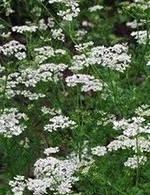 A native of Egypt and the Mediterranean anise has been known since ancient times. In the sixth century BC it was recommended for controlling epileptic seizures but by Roman times it was grown for its fragrance, flavor and medicinal properties. Anise has a long list of medicinal properties in folk medicine but is known to aid indigestion and prevent flatulence. The essential oil is a mild expectorant so it is useful in cough medicine. The licorice flavor of anise has long been appreciated and ground or whole seed has been used to enhance eggs, cheese, vegetables, bread, mean and fish. It is used in making liquers and mixed with coriander, fennel, and sugared vodka to make anisetta.
A native of Egypt and the Mediterranean anise has been known since ancient times. In the sixth century BC it was recommended for controlling epileptic seizures but by Roman times it was grown for its fragrance, flavor and medicinal properties. Anise has a long list of medicinal properties in folk medicine but is known to aid indigestion and prevent flatulence. The essential oil is a mild expectorant so it is useful in cough medicine. The licorice flavor of anise has long been appreciated and ground or whole seed has been used to enhance eggs, cheese, vegetables, bread, mean and fish. It is used in making liquers and mixed with coriander, fennel, and sugared vodka to make anisetta.
Type: Annual herb
Bloom: In summer, small white flowers are produced in compound umbels at the top of round, grooved stems and resemble Queen Anne’s lace
Foliage: Lowers leaves are roundish, heart-shaped, and coarsely toothed; upper leaves are pinnately compound or lobed and give a feathery appearance.
Size: 2-3’ H
Light: Full sun
Soil: Lean to fertile, light, well-drained
Care: Harvest seeds by cutting the whole flower head when the seed are ripe and dry them in a bag to collect the seeds as the fall.
Pests and Diseases: None of importance
Propagation: Seed. Anise has a long taproot and does not transplant well so start seeds in peat pots or seed bed when soil is warm. Seed germinate at 70o F.
Companion plants: Anise said to enhance the growth of coriander
Comments: Anise is tall and spindly so is easily damaged by wind.
